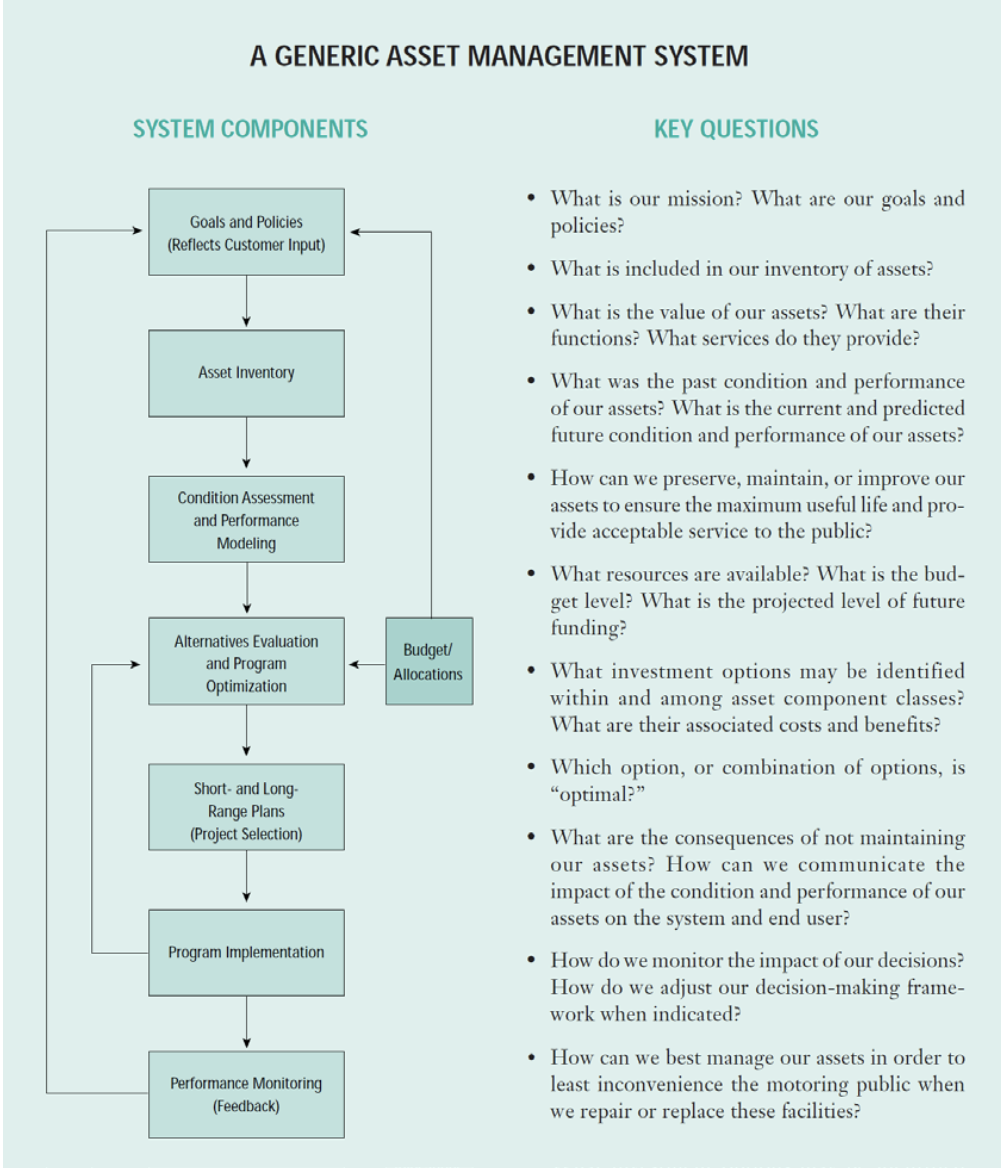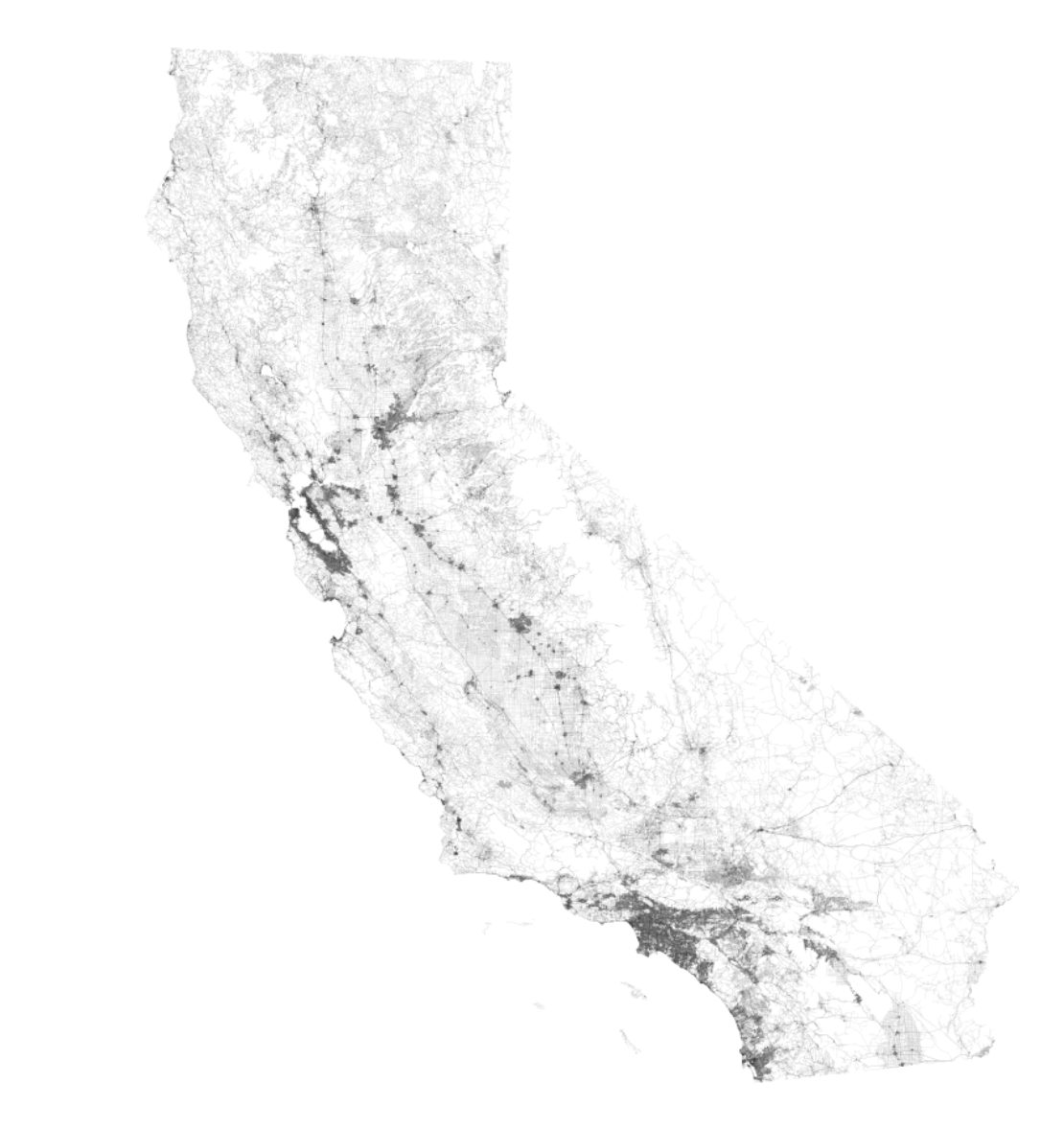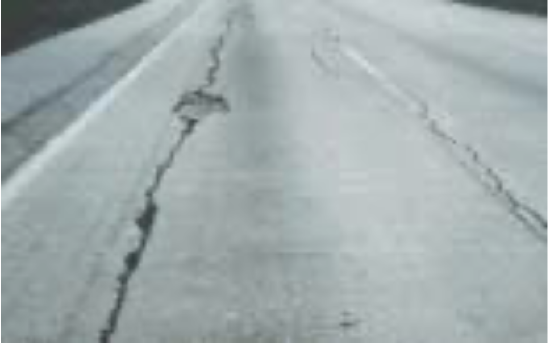2.2: Usual Elements of an Asset Management Process
- Page ID
- 21112
Figure 2.1 illustrates the typical steps in an asset management process. These steps would often be undertaken on an annual basis, although many of the elements might not change from year to year such as goals and policies. In the remainder of this section, we will comment upon the various components in the generic asset management systems in Fig. 2.1. Later chapters will examine these process steps in greater detail.

Goals and policies will differ among enterprises. For example, a water provider (e.g., a water utility) might have goals to provide a certain quantity of water within defined quality standards. Further, the water provider might have goals to preserve its physical infrastructure at a certain quality standard. A major difference in policies concerns corporate taxation. For private corporate-owned assets, the tax implications of depreciation and maintenance expenses may be important in the overall profitability of the corporation. Infrastructure managers must assess the specific goals and policies pertaining to their own enterprise.
Asset inventory identifies the numbers and types of assets available. For example, a roadway agency might keep track of the numbers and types of roads in their system, but also assets such as road signs and lane markings. Inventory is often hampered by the absence or loss of historic records, such as the exact locations of old underground pipes. Inventory changes over time as assets are created (through construction or purchase) or disposed of (through retirement or sale).
Computer aids are available for asset inventory. For fixed in place assets, geographic information systems may be quite helpful, showing the location and types of assets visually on a computer screen (Figure 2.2 provides an example of such a GIS inventory). For these aids, a standardized labeling or numbering system for assets is required. These identifiers are usually stored in an inventory database of asset information, but also installed on pieces of infrastructure themselves. For example, railway cars will have a standardized ‘reporting mark’ to indicate the owner of the car and its number. The identifiers may be written on the assets or stored in readable digital form by technologies such as radio frequency identifier (RFID) tags or bar codes. In many cases, computer aids pertain to individual assets such as bridges or roadway segments, and some form of ‘data gateway’ may be required to provide a holistic view of enterprise assets.
 Figure 2.2 - Geographic Information Systems Inventory of California Roads. Source: By RandomlyAdam - Own work, CC BY-SA 4.0, https://commons.wikimedia.org/w/inde...curid=35868125. Note the density around Los Angeles and San Francisco.
Figure 2.2 - Geographic Information Systems Inventory of California Roads. Source: By RandomlyAdam - Own work, CC BY-SA 4.0, https://commons.wikimedia.org/w/inde...curid=35868125. Note the density around Los Angeles and San Francisco.
Condition Assessment and Performance Modeling requires an assessment of the current functionality of each asset and often involves a forecast of asset deterioration. Condition assessment can be done mechanistically by assuming a standard deterioration with use and time, but more often involves active survey and/or sensing along with models of performance and deterioration. In many cases, condition assessment is summarized in a numerical rating score based on a survey, sensing or testing. Figure 2.3 shows a pavement segment having less than perfect conditions as an example.

Figure 2.3 - Example of longitudinal cracks affecting condition rating on a roadway segment. Source: FHWA Distress Identification Manual for The LTPP, 2003, Public Domain, https://www.fhwa.dot.gov/publication...ts/03031/03.cf m#fig92.
Alternatives Evaluation and Program Optimization is a process step to plan asset maintenance, rehabilitation or replacement for the planning horizon. In this step, managers need to formulate reasonable alternatives for asset improvement. For a roadway segment, alternatives might include various maintenance activities (such as crack sealing or pothole patching), repaving (such as milling off the top layer of asphalt and placing a layer of smooth, recycled asphalt), or reconstruction. Of course, any asset management plan will have to be modified over time in response to changing conditions or priorities.
Computer aids can also be useful in the process of alternatives evaluation and program optimization. Databases of possible alternative actions (and their costs and other characteristics) are helpful. Optimization programs to minimize costs may be employed. Alternatives evaluation can also involve multiple stages, with preliminary investigation followed by a detailed analysis of a final set of possible actions.
Budget and Allocations define the resources available for asset management and will influence selection of management alternatives. In effect, most infrastructure managers are constrained by the allocation of resources and budgets available in any particular period. As shown in Figure 2.1, budget and allocations may also influence the goals and policies defined for the entire process.
Short and Long Range Plans (Project Selection) develops a plan of action for selected alternatives over periods of time. ‘Short-range’ typically is a yearlong planning
horizon, although it might be as short as scheduling activities over the course of a day or week. Long-range plans usually involve major projects and may involve a significant planning process. For discussion of long-range planning, see Hendrickson (2016). Plans usually involve the infrastructure management organization itself, but often include provisions to contract out for specific projects.
A component of most infrastructure management short-range plans is a process for responding to routine maintenance requests. For example, a building manager might have a systematic plan for replacing light bulbs in the building, but would also respond to reports of burnt out or broken lights.
Program Implementation is the process of actually completing the selected projects. For example, a City might plan to repave 200 kilometers of designated roadway segments over the course of a construction season. Program implementation involves actually doing the repaving work.
Performance Monitoring (Feedback) is a means of providing continuous feedback information on asset management performance. While Fig. 2.1 shows this feedback as a flow into goals and policies, the feedback can influence all stages of the asset management process. For example, the performance of particular maintenance or rehabilitation alternatives may inform alternatives evaluation and project selection. Performance monitoring often involves measures of infrastructure usage and quality of services provided in addition to direct information on asset management actions.


